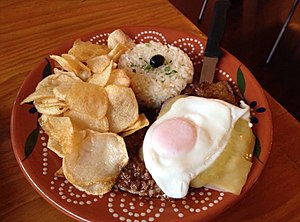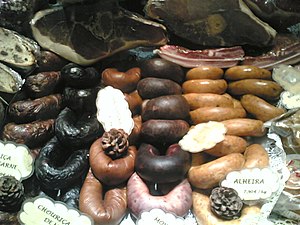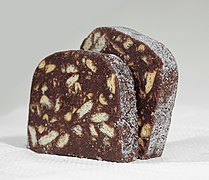Portuguese cuisine/ja: Difference between revisions
No edit summary Tags: Mobile edit Mobile web edit |
Created page with "マデイラワインは、ジョージ・ワイスがトーマス・ジェファーソンに紹介した後、彼のお気に入りとなった。独立宣言とジョージ・ワシントンへの乾杯に使われ、ベッツィ・ロス、アレクサンダー・ハミルトン、ベンジャミン・フランクリン、:e..." Tags: Mobile edit Mobile web edit |
||
| (19 intermediate revisions by the same user not shown) | |||
| Line 177: | Line 177: | ||
''[[Doce de gila/ja|ドーセ・デ・ジラ]]''([[Cucurbita ficifolia/ja|チカヨテカボチャ]]から作られる)、ウエハースペーパー、そして''[[fios de ovos/ja|フィオス・デ・オーヴォス]]''または天使の髪と呼ばれる砂糖漬けの卵の糸がある。 | ''[[Doce de gila/ja|ドーセ・デ・ジラ]]''([[Cucurbita ficifolia/ja|チカヨテカボチャ]]から作られる)、ウエハースペーパー、そして''[[fios de ovos/ja|フィオス・デ・オーヴォス]]''または天使の髪と呼ばれる砂糖漬けの卵の糸がある。 | ||
<gallery mode="packed"> | <gallery mode="packed"> | ||
Pão-de-ló.jpg|Pão-de-Ló | Pão-de-ló.jpg|Pão-de-Ló | ||
Rabanadas, Christmas cakes (2135990222).jpg| | Rabanadas, Christmas cakes (2135990222).jpg|Rabanadasとフィリョス、典型的なクリスマスデザート | ||
Crème brûlée à la vanille.jpg|''Leite-creme'' | Crème brûlée à la vanille.jpg|''Leite-creme''(ポルトガル風[[Crème brûlée/ja|クレームブリュレ]]) | ||
ArrozDoce.jpg|Arroz | ArrozDoce.jpg|Arroz Doce([[Rice pudding/ja|ライスプディング]]) | ||
Bola de Berlim 1 by wax115.jpg|Bola de | Bola de Berlim 1 by wax115.jpg|Bola de Berlim([[Berliner (doughnut)/ja|ベルリーナー]]の一種) | ||
Salame de chocolate - Chocolat Salami.jpg|Salame de | Salame de chocolate - Chocolat Salami.jpg|Salame de Chocolate([[Chocolate salami/ja|チョコレートサラミ]]) | ||
</gallery> | </gallery> | ||
< | <span id="Influences_on_world_cuisine"></span> | ||
==Influences on world cuisine== | ==世界の料理への影響{{Anchor|Influences on world cuisine}}== | ||
[[File:Vindalho.jpg|thumb|right|他のポルトガル・ゴア料理と共に供されるゴア風豚肉の''[[Vindaloo/ja|ヴィンダルー]]'']] | |||
[[File:Vindalho.jpg|thumb|right| | [[File:Castella,made in nagasaki-city,japan.JPG|thumb|right|日本の[[:en:Nagasaki|長崎]]の名物である''Pão de Castela''(''[[Kasutera/ja|カステラ]]'')]] | ||
[[File:Castella,made in nagasaki-city,japan.JPG|thumb|right|''Pão de Castela'' | |||
ポルトガルはかつて[[:en:Portuguese Empire|広大な帝国]]を築いており、その料理は双方に影響を与え合ってきた。ポルトガルの影響は、中国領の[[:en:Macau|マカオ]]([[Macanese cuisine/ja|マカオ料理]])や、[[:en:Goa|ゴア]]や[[:en:Kerala|ケララ]]などの[[:en:Portuguese India|ポルトガル領インド]]であった地域に見られる。これらの地域では、''[[Vindaloo/ja|ヴィンダルー]]''(スパイシーな[[curry/ja|カレー]])に酢、唐辛子、ニンニクの組み合わせが見られる。 | |||
11世紀以来[[:en:southern Europe|南ヨーロッパ]]で広く栽培されてきたペルシャオレンジは苦味がありった。甘いオレンジは15世紀にポルトガルの商人によって[[:en:India|インド]]からヨーロッパにもたらされました。一部の東南インド・ヨーロッパ語族では、[[Orange (fruit)/ja|オレンジ]]をポルトガルにちなんで名付けている。ポルトガルはかつてオレンジの主要な輸入元であった。 | |||
例としては、[[:en:Albanian language|アルバニア語]]の''portokall''、[[:en:Bulgarian language|ブルガリア語]]の''portokal'' [портокал]、[[:en:Modern Greek|ギリシャ語]]の''portokali'' [πορτοκάλι]、[[:en:Persian language|ペルシャ語]]の''porteghal'' [پرتقال]、[[:en:Romanian language|ルーマニア語]]の''portocală''などがある。[[:en:Regional Italian|南イタリアの方言]]([[:en:Neapolitan language|ナポリ語]])では、オレンジは''portogallo''または''purtualle''と呼ばれ、文字通り「ポルトガルのもの」を意味します。類似の名称は他の言語でも見られる。[[:en:Turkish language|トルコ語]]の''Portakal''、[[:en:Arabic language|アラビア語]]の''al-burtuqal'' [البرتقال]、[[:en:Amharic|アムハラ語]]の''birtukan'' [ብርቱካン]、[[:en:Georgian language|グルジア語]]の''phortokhali'' [ფორთოხალი]などである。 | |||
ポルトガル人は、現在その伝統的なデザートや風味豊かな料理に惜しみなく使われているシナモン(''[[Cinnamomum verum/ja|クスノキ]]'')などのスパイスをアジアから輸入した。 | |||
ポルトガル料理の''"[[Canja de galinha/ja|カンジャ]]"''は、パスタまたは米で作られた[[chicken soup/ja|チキンスープ]]で、病人のための人気のある食養生として知られている。これはアジアの''[[congee/ja|おかゆ]]''と類似点があり、同じように使われていることから、東洋から伝わった可能性が示唆されている。 | |||
1543年、ポルトガル貿易船が[[:en:Japan|日本]]に到達し、当時贅沢品として珍重されていた精製糖をもたらした。[[:en:Daimyō|日本の大名]]はポルトガル菓子を非常に好み、それが現在の伝統的な日本の''[[konpeitō/ja|金平糖]]''(キャンディ)、''[[kasutera/ja|カステラ]]''([[sponge cake/ja|スポンジケーキ]])、''[[Fios de ovos/ja|鶏卵素麺]]''(ポルトガル語の"[[Wikipedia:fios de ovos|fios de ovos]]"の日本版で、[[Thai cuisine/ja|タイ料理]]でも「カノム・フォイ・トン」という名前で人気がある)として再構築され、''南蛮菓子''、つまり「新様式の[[Wagashi/ja|和菓子]]」が誕生した。この[[:en:Nanban trade|南蛮貿易]]の期間中、''[[tempura/ja|天ぷら]]''(ポルトガル語の''[[Wikipedia:peixinhos da horta|peixinhos da horta]]''に似ている)は、初期のポルトガル人宣教師によって日本に伝えらた。 | |||
[[File:Catarina de Bragança - Peter Lely 1665.jpg|thumb|right|[[Catherine of Braganza/ja|キャサリン・オブ・ブラガンザ]]は、イギリス宮廷に[[tea/ja|茶]]をもたらしたことで知られる]] | |||
[[Daimyō| | |||
[[File:Catarina de Bragança - Peter Lely 1665.jpg|thumb|right|[[Catherine of Braganza]] | |||
[[Tea/ja|お茶]]は、[[:en:Charles II of England|チャールズ2世]]とポルトガルの王女[[:en:Catherine of Braganza|キャサリン・オブ・ブラガンザ]](''Catarina De Bragança'')の結婚後、1660年代にイングランドで流行しました。キャサリンは、もともと[[Macanese cuisine/ja|マカオ]]の植民地由来のお茶の好みを宮廷にもたらしました。キャサリンがチャールズ王に嫁ぐために北に移動した際、彼女は個人的な持ち物の一部として茶葉を詰めていたと言われている。それはまた、彼女の持参金の一部であった可能性も高い。 | |||
[[Tea]] | キャサリン女王はまた、[[marmalade/ja|ママレード]]をイギリス人に紹介し、フォークを使って食事をする習慣を宮廷のテーブルマナーの一部とした。 | ||
世界中で、ポルトガル移民は[[Cuisine of Hawaii/ja|ハワイ]]や[[Cuisine of New England/ja|ニューイングランド]]の一部など、彼らの新しい「故郷」の料理に影響を与えた。''Pão doce''([[Portuguese sweet bread/ja|ポルトガル風甘いパン]])、''[[malassada/ja|マラサダ]]''、''sopa de feijão''(豆のスープ)、ポルトガルソーセージ(''[[linguiça/ja|リングイサ]]''や''[[chouriço/ja|チョリソ]]''など)は、ハワイ諸島で民族を問わず家族全員が日常的に食べている。同様に、「[[papo-seco/ja|パポ・セコ]]」は開いた食感を持つポルトガル風パンで、[[:en:Jersey|ジャージー島]]のカフェの定番となっている。ジャージー島にはかなりの数のポルトガル系コミュニティがある。 | |||
[[:en:Australia|オーストラリア]]と[[:en:Canada|カナダ]]では、主に[[fast food/ja|ファストフード]]店で販売されている「ポルトガル風」チキンのバリエーションが、過去20年間で非常に人気が高まっている。提供される料理には、伝統的な鶏肉料理と様々な鶏肉および牛肉のハンバーガーが含まれる。「ポルトガル風チキンサンドイッチ」のような一部のケースでは、提供される料理はポルトガル料理とは緩やかな関連性しかなく、通常は「ピリピリソース」(''[[piri piri/ja|ピリピリ]]''で作られたポルトガルソース)の使用のみに限定されている。 | |||
ポルトガルは[[African cuisine/ja|アフリカ料理]]に大きな影響を与え、その逆もまた然りである。彼らは[[Maize/ja|トウモロコシ]]をアフリカ大陸に導入した責任がある。その結果、[[:en:South Africa|南アフリカ]]のレストランチェーン[[:en:Nando's|Nando's]]などは、[[Cuisine of East Timor/ja|東ティモール料理]]も影響を受けたアジアなど、世界中にポルトガル料理を広めるのに貢献している。 | |||
<span id="Madeira_wine_and_early_American_history"></span> | <span id="Madeira_wine_and_early_American_history"></span> | ||
===マデイラワインと初期アメリカの歴史=== | ===マデイラワインと初期アメリカの歴史=== | ||
[[File:Funchal D Oliveiras inside 2016 3.jpg|thumb|right|[[:en:Funchal|フンシャル]](マデイラ島)にある、マデイラワインの生産と販売に特化したワインハウスの屋内]] | |||
[[File:Funchal D Oliveiras inside 2016 3.jpg|thumb|right| | |||
18世紀、[[Madeira wine/ja|マデイラワイン]]は[[:en:British America|イギリス領アメリカ]]で絶大な人気を博した。特に樽熟成のマデイラワインは、裕福なヨーロッパ人入植者が消費する高級品であった。価格は18世紀初頭の5ポンドから、19世紀初頭には43ポンドにまで高騰した。1775年の[[:en:First Continental Congress|第一次大陸会議]]では、祝杯としてマデイラワインが供された。 | |||
マデイラワインはアメリカ合衆国の歴史において重要なワインであった。13の植民地ではワインに適したブドウを栽培できなかったため、輸入が必要であり、マデイラに大きな重点が置かれた。革命への道のりでマデイラワインが重要な役割を果たした主要な出来事の一つは、1768年5月9日にイギリス税関職員によって[[:en:John Hancock|ジョン・ハンコック]]のスループ船''[[:en:HMS Liberty (1768)|リバティ号]]''が差し押さえられたことである。ハンコックの船は、彼がマデイラワイン25樽(3,150ガロン)の貨物を陸揚げした後、輸入関税をめぐる紛争が発生して差し押さえられた。''リバティ号''の差し押さえは、[[:en:Boston|ボストン]]市民の間に暴動を引き起こした。 | |||
マデイラワインは、[[:en:George Wythe|ジョージ・ワイス]]が[[:en:Thomas Jefferson|トーマス・ジェファーソン]]に紹介した後、彼のお気に入りとなった。独立宣言と[[:en:George Washington|ジョージ・ワシントン]]への乾杯に使われ、[[:en:Betsy Ross|ベッツィ・ロス]]、[[:en:Alexander Hamilton|アレクサンダー・ハミルトン]]、[[:en:Benjamin Franklin|ベンジャミン・フランクリン]]、[[:en:John Adams|ジョン・アダムズ]]もマデイラワインの品質を高く評価していたと言われている。このワインはベンジャミン・フランクリンの自伝にも言及されている。ある時、アダムズは妻アビゲイルに、大陸会議のマサチューセッツ代表であった間、彼が大量のマデイラワインを消費したことについて手紙を書いた。1797年には、来訪したジェームズ・サーバー船長によってUSS ''Constitution''の命名式でマデイラワインのボトルが使われた。[[:en:John Marshall|ジョン・マーシャル]]最高裁長官もまた、初期の米国最高裁判所の同僚裁判官と同様にマデイラワインを高く評価していたことで知られている。 | |||
== 関連項目 == | == 関連項目 == | ||
Latest revision as of 18:37, 3 June 2025

| Culture of Portugal |
|---|
 |
| People |
| Cuisine |
| Festivals |
| Art |
ポルトガル料理(Portuguese: Cozinha portuguesa)は、ポルトガルにおける料理の伝統と慣習から成る。ポルトガル料理に関する現存する最古の書物である16世紀の『インファンタ・マリア・デ・ポルトガル料理書(Livro de Cozinha da Infanta D. Maria de Portugal)』には、肉、魚、鶏肉などの人気料理が多数記述されている。
「Olleboma」として知られるアントニオ=マリア・デ・オリベイラ・ベロによる『Culinária Portuguesa』は、1936年に出版された。 比較的大西洋、ケルト的な食料に限定されているにもかかわらず、ポルトガル料理にはフランス料理と地中海料理の強い影響も見られる。
ポルトガルの香辛料貿易が東インド、アフリカ、アメリカ大陸に与えた影響も顕著で、特に使用される香辛料の種類が豊富である。これらの香辛料には、「ピリピリ」(小さくて辛い唐辛子)、ホワイトペッパー、ブラックペッパー、サフラン、パプリカ、クローブ、オールスパイス、クミン、シナモン、ナツメグが含まれ、ポルトガル本土、アゾレス諸島、マデイラ諸島の肉料理、魚料理、または複数の風味豊かな料理に使用される。 シナモン、バニラ、レモンゼスト、オレンジゼスト、アニスシード、クローブ、オールスパイスは、多くの伝統的なデザートや一部の風味豊かな料理に使用される。
ニンニクとタマネギは広く使われており、ハーブも同様です。ローリエ、パセリ、オレガノ、タイム、ミント、マジョラム、ローズマリー、そしてコリアンダーが最も一般的です。

オリーブオイルはポルトガル料理の基本の一つで、調理にも料理の風味付けにも使われます。このため、ポルトガルでは酸度によってオリーブオイルが独自に分類されています。酸度1.5度のものは調理専用(バージンオリーブオイル)で、1度以下のものは魚、ジャガイモ、野菜にかけるのに適しています(エキストラバージン)。酸度0.7度、0.5度、さらには0.3度のものは、オリーブオイルの味が全く好きではない方や、マヨネーズやソースのように味が隠れるような用途で使いたい方のためにあります。
ポルトガル料理は大西洋式食事法に基づいており、肉類(豚肉、牛肉、鶏肉が主で、ジビエなど)、魚介類(魚、ロブスター、カニ、エビ、クルマエビ、タコなどの甲殻類、ホタテ、アサリ、フジツボなどの軟体動物)、多種多様な野菜類(アブラナ科)、豆類、そしてデザート(ケーキが最も多い)が含まれます。 ポルトガル人はしばしば食事とともに米、ジャガイモ、菜の花(「grelos」として知られています)、パンを摂取し、ポルトガル語圏やガリシア語の影響下にある国々には、伝統的な焼きたてパン、例えば「broa」のようなものが多数あり、地域や国によってバリエーションがあります。 広義には、ポルトガル料理とガリシア料理は多くの伝統と特徴を共有しています。
中世
中世、ポルトガル人は主に牧畜で生計を立てていた。彼らは穀物、野菜、根菜、豆類、栗、家禽、牛、豚などを栽培し、食料としていました。ほとんどの地域で漁業や狩猟も一般的でした。この時期には、ブドウの木やオリーブの木といった植物とともに、魚を保存するための新しい方法が導入されました。パン(ライ麦、小麦、大麦、オート麦)は広く消費され、ほとんどの人々の主食でした。 甘いオレンジは15世紀にポルトガルの商人によってポルトガルに持ち込まれました。今日の多くの食品、例えばジャガイモ、トマト、チリ、ピーマン、トウモロコシ、カカオ、バニラ、七面鳥などは、1492年のコロンブスによるアメリカ大陸到達まではヨーロッパでは知られていませんでした。
食事

ポルトガルの朝食は、多くの場合、バター、ハム、チーズ、またはジャムを添えた焼きたてのパンと、コーヒー、牛乳、紅茶、あるいはホットチョコレートから成る。エスプレッソコーヒー(コーヒーマシンの注ぎ口にちなんで「ビーカ」、またはイタリアのコーヒーマシン「ラ・チンバリ」にちなんで「シンバリーノ」と呼ばれることもある)は、朝食時や昼食後によく飲まれる人気の飲み物で、自宅やポルトガルの街中の多くのカフェで楽しまれている。 甘いペイストリーも非常に人気があり、朝食用のシリアルも牛乳やヨーグルト、フルーツと混ぜて食べられる。ポルトガル料理の最も際立ったシンボルの一つであるパステル・デ・ナタは、ポルトガルの朝食によく登場する。朝食時にも午後の軽食としても、エスプレッソとともに頻繁に楽しまれている。
昼食は、しばしば1時間以上かけて、正午から2時の間、通常は1時頃に提供され、夕食は一般的に8時頃に提供されます。主なコースは3つあり、昼食と夕食には通常スープが含まれます。ポルトガルの一般的なスープは「カルド・ヴェルデ」で、これは調理してピュレ状にしたジャガイモ、タマネギ、ニンニクをベースに、細かく刻んだコラードグリーンを加えたものです。スライスした「チョリソ」(燻製またはスパイシーなポルトガルソーセージ)が加えられることも多いですが、省略することも可能で、その場合は完全にヴィーガン対応のスープになります。
魚料理の中でも、塩漬けのタラ(バカリャウ)を使った料理が非常に普及している。最も人気のあるデザートは、「プディング・デ・オーヴォス」または「フラン・デ・カラメロ」として知られるカスタードプディング、「ムース・デ・ショコラ」として知られるチョコレートムース、「レイテ・クレーム」として知られるクレームブリュレ、シナモンで飾られた「アロス・ドーセ」として知られるライスプディング、そして「タルテ・デ・マサン」として知られるアップルタルトである。 また、羊、山羊、または牛乳から作られる多種多様なチーズもある。これらのチーズは、異なる種類のミルクの混合物を含むこともある。最も有名なのは、セーラ・ダ・エストレーラ地方の「ケイジョ・ダ・セーラ」、サン・ジョルジェ島の「ケイジョ・サン・ジョルジェ」、そして「レケイジョン」である。人気のペイストリーは「パステル・デ・ナタ」で、シナモンがよく振りかけられた小さなカスタードタルトである。
魚介類


ポルトガルは海に面した国であり、漁業が発達しており、これは食される魚介類の量に反映されている。同国の一人当たりの魚介類消費量はヨーロッパで最も高く、この指標では世界トップ4に入る。魚は、グリル、茹でる(ポシェや煮るも含む)、揚げる(素揚げも含む)、caldeiradaとして知られる煮込み料理(しばしば土鍋調理)、ロースト、あるいは蒸し物として供される。
中でも特筆すべきは、ポルトガルで最も消費される魚であるbacalhau(タラ)である。タラの調理法は365種類以上あると言われており、これは一年の毎日につき少なくとも一品があることを意味する。タラは、冷蔵技術の発明以前に北大西洋でのポルトガルの漁業が発展したため、ほとんど常に乾燥させ塩漬けされたものが用いられ、調理前に水または牛乳に浸す必要がある。シンプルな魚料理には、しばしばエクストラバージンオリーブオイルと白ワインビネガーで風味付けされる。
ポルトガルでは15世紀からタラの漁業と貿易が行われており、このタラの貿易がタラの料理における普及の理由となっている。その他の人気の魚介類には、新鮮なイワシ(特にsardinhas assadasとして)、シーバス、フエダイ、メカジキ、サバ、舌平目、ブリル、オヒョウ、マトウダイ、ターボット、アンコウ、タコ、イカ、コウイカ、カニ、エビ、ロブスター、イセエビ、そしてフジツボ、メルルーサ、マアジ(アジ類)、タチウオ(特にマデイラ諸島)、その他様々な魚や貝類、そしてアサリ、ムール貝、カキ、ホタテガイ、イシダタミガイなどの軟体動物といった、多くの甲殻類が含まれる。
カルディラーダは、様々な魚(ターボット、アンコウ、メルルーサ、ムール貝)や貝類からなる様々なシチューで、プロヴァンス地方のブイヤベースに似ている。また、肉やジビエと複数の野菜材料からなるものもある。これらのシチューは伝統的に、(ラピーニ) グレロス、ジャガイモ、トマト、ペリペリ、ピーマン、パセリ、ニンニク、タマネギ、ペニーロイヤル、そして一部の地域ではコリアンダーなどから構成される。
川のヤツメウナギやウナギは、淡水の珍味とされている。ポルトガル中央部のコインブラ地方やアヴェイロ地方は、ウナギのシチューやヤツメウナギの季節料理、祭りで有名である。アルガニルやペナコヴァでは、Arroz de LampreiaやLampreia à Bordalesaといった人気料理がある。

イワシはかつて、地方での販売のために塩水漬けにされて保存されていた。その後、ポルトガル沿岸各地でイワシの缶詰工場が発展した。エイはポルトガル北部で天日干しにされる。缶詰のマグロはポルトガル本土で広く流通している。マグロはかつてアルガルヴェ地方の海域で豊富に獲れた。マグロは地中海での産卵に向かう際にポルトガル南岸を通過する際、そして大西洋に戻る際に定置網で捕獲された。ポルトガルの作家ラウル・ブランダンは、著書『Os Pescadores』の中で、マグロがどのようにして引き上げられた網から船に釣り上げられたか、そして漁師たちが大きな魚に乗って網の周りを回って楽しんだ様子を描写している。しかし、新鮮なマグロは通常、マグロのステーキが郷土料理の重要な品目であるマデイラ諸島とアルガルヴェ地方で食される。缶詰のイワシやマグロは、茹でたジャガイモ、黒目豆、コラードグリーン、固ゆで卵と共に供され、手の込んだ料理を作る時間がない場合に手軽な食事となる。
肉と家禽

肉や家禽肉を日常的に食べることは、歴史的に上流階級の特権であった。豚肉と牛肉は、この国で最も一般的な肉である。肉は中世の貴族の食卓の主食であった。ポルトガルのルネサンス期の年代記作家、ガルシア・デ・レゼンデは、王室の晩餐会での主菜が、鶏肉で飾り付けられた丸ごと一頭のロースト雄牛であったと記述している。主に冬に食べられる一般的なポルトガル料理はcozido à portuguesaで、これはフランスのpot-au-feuやニューイングランド風煮込み料理にいくぶん似ている。その構成は料理人の想像力と予算に依存する。贅沢なコジードには、牛肉、豚肉、塩漬け豚肉、数種類のシャルキュトリー(塩漬けのチョリソ、モルセーラ・エ・チョリソ・デ・サングレ、リングイサ、ファリニェイラなど)、豚足、生ハム、ジャガイモ、ニンジン、カブ、キャベツ、米が含まれることがある。これは元々、裕福な農民のお気に入りの食べ物であり、後に都市のブルジョワジーや典型的なレストランの食卓に上るようになった。
肉



Tripas à moda do Porto (トリッパと白インゲン豆の煮込み)は、14世紀にカスティーリャ軍がリスボンを包囲し、テージョ川の入り口を封鎖した際に生まれたと言われている。ポルトガルの年代記作家フェルナン・ロペスは、飢餓が街中に広がり、食料価格が天文学的に高騰した様子を劇的に描写している。小さな少年たちはかつての小麦市場で地面に落ちた数粒の穀物を探し、見つけると熱心に口に入れたという。老人や病人、娼婦、要するに街の防衛に協力できない者は皆、カスティーリャ軍の陣営に送られたが、侵略者によってリスボンに送り返された。この時、ポルト市民は川の封鎖をかいくぐって補給艦隊を組織することを決意した。どうやら、一時的に利用できるすべての肉が首都に送られたため、ポルトの住民はトリッパや他の臓器に限定されたようだ。別の説では、ポルトが肉を自ら断ち、セウタ市を征服するための遠征に供給したのは1415年のことであったと主張している。真実が何であれ、少なくとも17世紀以来、ポルトの人々はトリペイロス、つまりトリッパ食いとして知られている。トリッパを使ったもう一つのポルトガル料理はドブラダである。
現在、ポルト地方は「フレンチー」を意味するfrancesinhaとして知られるトーストサンドイッチでも同様に有名である。
ポルトガル料理には他にも多くの肉料理がある。バイラーダ地方では、Leitão à Bairrada (子豚の丸焼き)という有名な料理がある。その近くでは、chanfana(ヤギ肉を赤ワイン、パプリカ、白胡椒でじっくり煮込んだもの)という別の料理が、ミランダ・ド・コルヴォ(「チャンファーナの首都」)とヴィラ・ノヴァ・デ・ポイアレス(「チャンファーナの世界首都」)の2つの町に由来を主張されている。 Carne de porco à alentejanaは、豚肉とアサリの炒め物で人気のある料理だが、その名前と起源については諸説ある。アサリは、アレンテージョ地方ではあまり一般的ではないだろう。この地方には、シネスという一つの大きな漁港と小さな漁村しかないからである。むしろ、アルガルヴェ地方とその海辺の町でははるかに広く使われているだろう。この料理がアルガルヴェ地方に属するという説の一つは、この地方の豚がかつて魚の副産物を餌としていたため、肉の生臭さを隠すためにアサリが豚肉の炒め物に加えられたというものである。この料理は中世において、改宗ユダヤ人の新しいキリスト教信仰を試すために用いられた。豚肉と魚介類(コーシャーではない二つの食材)からなるこの料理を、クリスタオス・ノーヴォスは、ユダヤ教を放棄したことを証明するために公衆の面前で食べることが求められた。アルト・アレンテージョ(北アレンテージョ)には、豚肉または子羊肉の肺、血、肝臓を使った料理がある。この伝統的なイースター料理は、一年を通して他の時期にも食べられる。地域に伝わる島の料理、アルカトラは、牛肉を赤ワイン、ニンニク、クローブやオールスパイスなどの香辛料でマリネし、土鍋で焼いたもので、アゾレス諸島のテルセイラ島の伝統である。
ポルトガル風ステーキのbifeは、スパイスに漬け込んだ牛肉または豚肉のソテーで、ワインベースのソースとフライドポテト、ライス、またはサラダが添えられる。肉の上に目玉焼きを乗せることもあり、その場合、料理はbife com ovo a cavalo(馬に乗った卵つきステーキ)という新しい名前になる。この料理は、肉がグリルに2回しか「触れない」ことを意味するbitoqueと呼ばれることもある。これは、肉が提供される前にあまり長くグリルされず、レアからミディアムレアの焼き加減になることを意味する。bifeのもう一つのバリエーションはbife à casa(ハウスステーキ)で、これはbife a cavaloに似ていることもあれば、アスパラガスなどの付け合わせが特徴であることもある。
Iscas(レバーのソテー)は、昔のリスボンの居酒屋で人気の注文だった。時にはiscas com elasと呼ばれ、elasはソテーしたジャガイモを指した。ロールパンに入った小さな牛肉や豚肉のステーキ(それぞれpregosやbifanas)は人気の軽食で、しばしばビアホールで大きなビールジョッキと共に供される。現代では、スナックバーのカウンターで食べるpregoやbifanaが、それ自体でランチになることもある。 Espetada(串焼き肉)は、マデイラ島で非常に人気がある。
シャルキュトリー

トラズ・オス・モンテス地方の黄色いソーセージアルヘイラは、伝統的にフライドポテトと目玉焼きと共に供され、興味深い歴史を持つ。15世紀後半、ポルトガル王マヌエル1世は、居住するすべてのユダヤ人にキリスト教への改宗か国外退去を命じた。 王は、王国の経済的・専門的エリートを構成していたユダヤ人を追放することを本心では望んでいなかったが、外部からの圧力によりそうせざるを得なかった。そのため、期限が到来すると、改宗を拒否した大多数の人々には船が利用できないと発表し、男性、女性、子供たちを強制的に教会に連行し、強制的な集団洗礼を行わせた。船の近くで洗礼を受けた者もおり、これは当時人気を博した概念「baptizados em pé」、文字通り「立ちながら洗礼を受けた」を生み出した。一部のユダヤ人は密かに信仰を守りながらも、善良なキリスト教徒のイメージを示そうとしたと考えられている。豚肉を避けることはポルトガル異端審問の目には明らかな慣行であったため、新キリスト教徒たちは、豚肉でできているように見せかけるが、実際には香辛料を大量に効かせたジビエと鶏肉のみを含むソーセージを考案した。時が経つにつれて、豚肉がアルヘイラに加えられるようになった。 PGI保護認定されたアルヘイラの品種には、Alheira de ヴィニャイスとAlheira de Barroso-Montalegre Municipalityがある。
ChouriçoまたはChouriça(後者は通常、より大きく厚いものを指す)は独特のソーセージであり、チョリソーと混同してはならない。これは(少なくとも)豚肉、脂身、パプリカ、ニンニク、塩(ワインや時にコショウも一部の地域では一般的な材料である)で作られる。その後、豚や子羊の天然ケーシングに詰められ、ゆっくりと煙で乾燥される。多種多様な品種があり、色、形、スパイス、味が異なる。白胡椒、ピリピリ、クミン、シナモンは、ポルトガルの旧植民地や島々でしばしば追加される。伝統的なポルトガルの硬化チョリソの種類はより肉厚で、しばしば赤ワインが使われ、スパイスはあまり多くない。多くのポルトガル料理では、cozido à portuguesaやfeijoadaなど、chouriçoが使用される。
ファリニェイラは、小麦粉を主原料とするもう一つのポルトガル燻製ソーセージである。このソーセージは、コジード・ア・ポルトゥゲーザなどの伝統料理の材料の一つである。ボルバ、エストレモス、ポルタレグレのファリニェイラはすべて、欧州連合において「PGI」(保護地理的表示)を受けている。

プレスント(プロシュートハム)は、ポルトガルで非常に多くの種類があり、最も有名なものはシャベス地方のものである。プレスントは通常、薄切りまたは小さく切って、食前酒や紅茶と共に、あるいは様々な料理の材料として消費される。
プレズントには、PDO(原産地名称保護)またはPGI(地理的表示保護)によって欧州法で保護されているいくつかの種類があり、例えばバランコス産プレズントやヴィニャイス産ビサロプレズントなどがある。
Porco bísaroは、PDOの地位を持つ、ポルトガルの貴重な固有豚種である。この品種から派生したいくつかの製品、例えば「ブーショ・デ・ヴィニャイス」、「チョリソ・デ・オッソス・デ・ヴィニャイス」、「チョリサ・ドーチェ・デ・ヴィニャイス」もPGIの地位を有している。 ポルトガル王国の本土における一般家畜調査(1870年)によると、「...ビサロとは、引き締まった、多かれ少なかれ脚の長い、耳の垂れた豚のことで、アレンテージョの良い太った有害な豚と区別される」。サンソンは「ケルト」という名称を提案し、この種類の品種の古さを表現するために使用している。この品種は、ポルトガル北部やガリシア、旧ガリア、イギリス諸島など、ケルト人が居住していた地域に唯一存在していた品種であり、アジア種やロマネスク種がこれらの国に導入される以前から存在していた。
1878年、マセド・ピントはビサロ豚を「Typo Bizaro」または「Celta」に属する動物として記述し、上記の形態的特徴を持ち、体格、色、毛の多寡によって品種内の2つの変種を区別した。

彼は、枝肉200〜250kgの豚と120〜150kgの豚が存在すると考えた。色については、ほとんどが黒で、斑点のあるものもおり、白い毛のものはガリシア産であるため「ガレゴ」と呼ばれたという。モラリニョスは、毛が少なく滑らかでつるつるした皮膚を持つ斑点のある動物であった。 同著者によると、ビサロ豚は成長が遅く、肥育が難しい(2歳でようやく成長を完了する)、脂身よりも赤身肉を多く生産し、厚いベーコンの層よりも脂身を蓄積するとも述べている。 1946年、クーニャ・オルティゴーザは、ケルト族を起源とする「Bísara」品種を3つの国定品種の1つとして分類している。彼は、品種内の変種を記述する際、「Galega」と、「Molarinho」および「Cerdões」サブタイプを含む「Beirôa」に加えて分類している。
ポルトガルのハムやソーセージ(それぞれシャルキュトリー、エンチードス)には、肉の調理、味付け、保存、消費において、長く多様な伝統がある。これらは、熟成、塩漬け、燻製、加熱、煮込み、発酵、揚げ物、包み、乾燥といった様々な方法で加工される。形や風味、特産品、名称にも地域差が見られる。その他の豚肉(およびその他の肉)のシャルキュトリー製品には、toucinho(トゥシーニョ)、paio(パイオ)、morcela(モルセーラ)、beloura(ベロウラ)、bucho(ブーショ)、butelo(ブテロ)、cacholeira(カショレイラ)、maranho(マラーニョ)、ペルニル、salpicão(サルピカオン)などがある。
家禽

鶏肉、鴨肉、七面鳥、イワシャコ、ウズラはすべてポルトガル料理の要素である。料理には、フランゴ・ノ・シュラスコ(シュラスコ風鶏肉)、チキンピリピリ、cabidela rice、カンジャ・デ・ガリーニャ、arroz de pato(鴨肉ご飯)などがある。
七面鳥は、クリスマスや結婚披露宴、宴会などの特別な場合にのみ食された。1930年代まで、リスボン郊外の農民たちはクリスマス時期になると、七面鳥の群れを市街に連れてきて販売していた。現在では、養鶏場での大量生産により、これらの肉はすべての階級が手に入れられるようになった。Bifes de peru、つまり七面鳥のステーキは、こうしてポルトガルの食卓に加わったのである。
野菜とでんぷん

ポルトガル料理で人気の野菜には、数種類のキャベツやコラード、芽キャベツ(伝統的にカブや様々なキャベツの新芽から採れる)、トマト、玉ねぎ、エンドウ豆などがある。フェジョアーダのような黒豆と牛肉、豚肉を煮込んだ濃厚なシチューや、ポルトガル風パンのスープであるアソルダなど、でんぷん質の多い料理も多い。数多くのcozido(煮込み料理)には、ケール、白インゲン豆、赤インゲン豆、カタリーノ豆、ブラガンサーノ豆、ソラマメ、黒目豆などが使われる。meninaやporqueiraといった数種類のカボチャは、スープやスフレに使われる。 数多くの野菜とでんぷん質が豊富なスープやブロスの一つがcaurdoまたはcaldo à Lavradorで、キャベツ、赤インゲン豆、ジャガイモ、プロシュートの塊、小麦粉で作られたスープである。
多くの料理には、トマト、レタス、千切りにしたニンジン、タマネギで作られたサラダが添えられ、通常、オリーブオイルと酢で味付けされる。ジャガイモと米もポルトガル料理では非常に一般的である。様々な野菜、根菜、肉、豆から作られるスープも広く普及しており、特に人気があるのはカルド・ヴェルデである。これは、薄切りにしたケール、ジャガイモのピューレ、そしてチョリソのスライスから作られる。
果物、ナッツ、ベリー

新世界からジャガイモが伝わる以前は、栗(Castanea sativa)が季節の主食として広く使われていた。ポルトガルでは栗を使った料理、デザート、コンポートが復活しており、ポルトガル中部から北部にかけての内陸部では生産が盛んである。
洋梨、リンゴ、食用ブドウ、プラム、ピーチ、サクランボ、酸味のあるサクランボ、メロン、スイカ、柑橘類、イチジク、ザクロ、アプリコット、クルミ、松の実、アーモンド、ヘーゼルナッツ、イチゴ、ラズベリー、ブラックベリー、レッドカラント、ブルーベリーなどの他の季節の果物、ナッツ、ベリー類もポルトガルの食生活の一部である。これらはそのまま食べられたり、デザート、マーマレード、コンポート、ゼリー、リキュールとして使われたりする。
チーズ

ポルトガルには、牛乳、山羊乳、羊乳から作られる様々なチーズがある。これらは通常、非常に風味が強く、香り高い。伝統的なポルトガル料理にはチーズがレシピに含まれないため、通常はメイン料理の前後で単独で食される。非常に風味が強いケイジョ・ダ・セーラ・ダ・エストレーラは、柔らかい状態でも熟成させた状態でも食される。セーラ・ダ・エストレーラは、新鮮な羊乳とアザミ由来のレンネットから手作りされる。アゾレス諸島には、牛乳から作られるスパイシーな風味のチーズ、ケイジョ・サン・ジョルジェがある。その他、ケイジョ・デ・アゼイタン、ケイジョ・デ・カステロ・ブランコなど、原産地名称保護を受けた有名なチーズがある。Queijo mestiço de Tolosa は、保護地理的表示を持つ唯一のポルトガルチーズで、ニサ市のトロサ教区で生産され、ポルタレグレ県内にはケイジョ・デ・ニサという別の地方品種がある。
コーヒー
アルコール飲料
ワインとビール


ワイン(赤、白、「緑」)はポルトガルの伝統的な飲み物であり、ロゼはポルトガル国外の市場で人気があるが、ポルトガル国内ではそれほど一般的ではない。 「緑のワイン」と訳されるヴィーニョ・ヴェルデは、赤、白、ロゼのいずれでもあり得る特定の種類のワインで、ポルトガル北西部(ミーニョ県)でのみ生産される。これは飲み物の色ではなく、このワインが「若い」状態で飲まれる必要があるという事実を指す。「緑のワイン」は新しいワインとして消費されるべきであり、「マドゥーロ」ワインは通常、一定の熟成期間を経てから消費される。緑のワインは通常、わずかに発泡性がある。
ドウロ川とその支流の片岩質の斜面で伝統的に栽培されてきたポートワインは、ドウロ地方で生産される独特の風味を持つ酒精強化ワインで、通常はデザートと共に供される。
ミーニョ地方のアルヴァリーニョ種の白ワインも非常に人気が高い。
Vinho da Madeiraは、マデイラ諸島で生産されるシェリーに似た地方ワインである。 ワイン生産で残るブドウの絞りかすを蒸留して作られる様々なブランデー(アグアルデンテ、文字通り「燃える水」と呼ばれる)は、非常に強い風味を持つ。 リコール・ベイラウンやジンジーニャなどの典型的なリキュールは、ポルトガルで非常に人気のあるアルコール飲料である。南部、特にアルガルヴェ地方では、イチゴの木の果実から作られるメドローニョと呼ばれる蒸留酒がある。
ビールは、ルシタニア人がワインよりもはるかに多くビールを飲んでいた紀元前の時代からすでに消費されていた。「cerveja」(cervesia < cerevisia)というラテン語化された単語は、ガリアで使用されていたより古いケルト語に由来する。レコンキスタの間、北ヨーロッパからの多くの騎士は地元のワインよりもビールを好んだ。ポルトガルではCervejariaと呼ばれる「ビアガーデン」文化は、すべての地域で広く普及しており、いくつかの地元のブランドは地元の人々にも観光客にも人気がある。リスボンにはポルトガルおよびポルトガル語圏の国のビールの伝統に焦点を当てたビール博物館がある。
ペイストリーと菓子


ポルトガル菓子は西洋料理の発展に大きな影響を与えてきた。ママレード、キャラメル、糖蜜、砂糖など多くの言葉がポルトガル語に由来している。
pão de lóと呼ばれるポルトガル風スポンジケーキは、17世紀のフランスのレシピpain de lofを元にしていると考えられており、それはさらにオランダ語の「loef」に由来する。フランス人は最終的に彼らのケーキをジェノワーズと呼んだ。
おそらくポルトガルの菓子の中で最も有名なものは、19世紀初頭にリスボン同名の地区でPastéis de Belémとして知られていたパステル・デ・ナタであろう。このレシピがいつどこで初めて作られたかは不明である。 軍事宗教キリスト騎士団の修道士たちは、少なくとも14世紀初頭から同じ場所の教会に住み、航海中の船員に援助を提供していた。
アヴィス朝とジェロニモス修道院がそれに続き、修道院は最終的にヒエロニムス修道士によって占有された。1820年の自由主義革命後、すべての修道会が閉鎖される事態となった。パステル・デ・ベレンは、そこで職を失った人々によって、ジェロニモス修道院のすぐ外で初めて商業化された。修道院に隣接するオリジナルの菓子店は、今日でも営業している。このペストリーは現在、世界中で見られ、英国では元の名前、またはPortuguese custard tartとしても知られている。2011年、ポルトガル国民は70以上の国民料理のリストに投票し、最終的にパステル・デ・ナタをポルトガル美食の七不思議の1つとした。
国内の典型的なペストリーの多くは、中世の修道院で修道女や修道士によって作られ、収入を補う手段として販売されていた。これらのデザートの名前は通常、修道院生活に関連している。barriga de freira(修道女のお腹)、パポス・ド・アンジョ(天使の二重顎)、toucinho do céu(天国のベーコン)。 そのため、これらはしばしばドゥサリア・コンヴェントゥアルまたはreceitas monásticas(修道院のレシピ)と呼ばれます。その遺産は15世紀にまで遡り、海外からの砂糖がすべての階級にとって入手しやすくなったことが背景にある。当時の修道女は、しばしば家庭から知識を受け継ぎ、レシピを開発した若い貴族であった。これらのレシピは、通常、修道院の秘密裏に世代から世代へと受け継がれ、完成されていった。今日のポルトガルのデザートの多くは、修道院から生まれたものであ ur。
ポルトガル南部におけるアンダルシアの影響は、イチジク、アーモンド、ハチミツを取り入れたお菓子、すなわちアルガルヴェのマジパンの色鮮やかなお菓子や、telhas d’amêndoaとして知られるアーモンドのテュイルに見られる。
ほとんどの町には、通常、卵またはクリームベースのペストリーである地元名物がある。いくつかの例としては、leite-creme(卵カスタードベースに固いキャラメルの層を乗せたデザートで、クレームブリュレの変種)やプディム・フランなどがあル。
国内のほとんどのカフェ、ベーカリー、菓子店で見られるその他の非常に人気のあるペストリーは、ボーラ・デ・ベルリン、ボーロ・デ・アロース、テンチューガル・ペストリーである。
ドーセ・デ・ジラ(チカヨテカボチャから作られる)、ウエハースペーパー、そしてフィオス・デ・オーヴォスまたは天使の髪と呼ばれる砂糖漬けの卵の糸がある。
-
Pão-de-Ló
-
Rabanadasとフィリョス、典型的なクリスマスデザート
-
Leite-creme(ポルトガル風クレームブリュレ)
-
Arroz Doce(ライスプディング)
-
Bola de Berlim(ベルリーナーの一種)
-
Salame de Chocolate(チョコレートサラミ)
世界の料理への影響


ポルトガルはかつて広大な帝国を築いており、その料理は双方に影響を与え合ってきた。ポルトガルの影響は、中国領のマカオ(マカオ料理)や、ゴアやケララなどのポルトガル領インドであった地域に見られる。これらの地域では、ヴィンダルー(スパイシーなカレー)に酢、唐辛子、ニンニクの組み合わせが見られる。
11世紀以来南ヨーロッパで広く栽培されてきたペルシャオレンジは苦味がありった。甘いオレンジは15世紀にポルトガルの商人によってインドからヨーロッパにもたらされました。一部の東南インド・ヨーロッパ語族では、オレンジをポルトガルにちなんで名付けている。ポルトガルはかつてオレンジの主要な輸入元であった。
例としては、アルバニア語のportokall、ブルガリア語のportokal [портокал]、ギリシャ語のportokali [πορτοκάλι]、ペルシャ語のporteghal [پرتقال]、ルーマニア語のportocalăなどがある。南イタリアの方言(ナポリ語)では、オレンジはportogalloまたはpurtualleと呼ばれ、文字通り「ポルトガルのもの」を意味します。類似の名称は他の言語でも見られる。トルコ語のPortakal、アラビア語のal-burtuqal [البرتقال]、アムハラ語のbirtukan [ብርቱካン]、グルジア語のphortokhali [ფორთოხალი]などである。
ポルトガル人は、現在その伝統的なデザートや風味豊かな料理に惜しみなく使われているシナモン(クスノキ)などのスパイスをアジアから輸入した。
ポルトガル料理の"カンジャ"は、パスタまたは米で作られたチキンスープで、病人のための人気のある食養生として知られている。これはアジアのおかゆと類似点があり、同じように使われていることから、東洋から伝わった可能性が示唆されている。
1543年、ポルトガル貿易船が日本に到達し、当時贅沢品として珍重されていた精製糖をもたらした。日本の大名はポルトガル菓子を非常に好み、それが現在の伝統的な日本の金平糖(キャンディ)、カステラ(スポンジケーキ)、鶏卵素麺(ポルトガル語の"fios de ovos"の日本版で、タイ料理でも「カノム・フォイ・トン」という名前で人気がある)として再構築され、南蛮菓子、つまり「新様式の和菓子」が誕生した。この南蛮貿易の期間中、天ぷら(ポルトガル語のpeixinhos da hortaに似ている)は、初期のポルトガル人宣教師によって日本に伝えらた。

お茶は、チャールズ2世とポルトガルの王女キャサリン・オブ・ブラガンザ(Catarina De Bragança)の結婚後、1660年代にイングランドで流行しました。キャサリンは、もともとマカオの植民地由来のお茶の好みを宮廷にもたらしました。キャサリンがチャールズ王に嫁ぐために北に移動した際、彼女は個人的な持ち物の一部として茶葉を詰めていたと言われている。それはまた、彼女の持参金の一部であった可能性も高い。 キャサリン女王はまた、ママレードをイギリス人に紹介し、フォークを使って食事をする習慣を宮廷のテーブルマナーの一部とした。
世界中で、ポルトガル移民はハワイやニューイングランドの一部など、彼らの新しい「故郷」の料理に影響を与えた。Pão doce(ポルトガル風甘いパン)、マラサダ、sopa de feijão(豆のスープ)、ポルトガルソーセージ(リングイサやチョリソなど)は、ハワイ諸島で民族を問わず家族全員が日常的に食べている。同様に、「パポ・セコ」は開いた食感を持つポルトガル風パンで、ジャージー島のカフェの定番となっている。ジャージー島にはかなりの数のポルトガル系コミュニティがある。
オーストラリアとカナダでは、主にファストフード店で販売されている「ポルトガル風」チキンのバリエーションが、過去20年間で非常に人気が高まっている。提供される料理には、伝統的な鶏肉料理と様々な鶏肉および牛肉のハンバーガーが含まれる。「ポルトガル風チキンサンドイッチ」のような一部のケースでは、提供される料理はポルトガル料理とは緩やかな関連性しかなく、通常は「ピリピリソース」(ピリピリで作られたポルトガルソース)の使用のみに限定されている。
ポルトガルはアフリカ料理に大きな影響を与え、その逆もまた然りである。彼らはトウモロコシをアフリカ大陸に導入した責任がある。その結果、南アフリカのレストランチェーンNando'sなどは、東ティモール料理も影響を受けたアジアなど、世界中にポルトガル料理を広めるのに貢献している。
マデイラワインと初期アメリカの歴史

18世紀、マデイラワインはイギリス領アメリカで絶大な人気を博した。特に樽熟成のマデイラワインは、裕福なヨーロッパ人入植者が消費する高級品であった。価格は18世紀初頭の5ポンドから、19世紀初頭には43ポンドにまで高騰した。1775年の第一次大陸会議では、祝杯としてマデイラワインが供された。
マデイラワインはアメリカ合衆国の歴史において重要なワインであった。13の植民地ではワインに適したブドウを栽培できなかったため、輸入が必要であり、マデイラに大きな重点が置かれた。革命への道のりでマデイラワインが重要な役割を果たした主要な出来事の一つは、1768年5月9日にイギリス税関職員によってジョン・ハンコックのスループ船リバティ号が差し押さえられたことである。ハンコックの船は、彼がマデイラワイン25樽(3,150ガロン)の貨物を陸揚げした後、輸入関税をめぐる紛争が発生して差し押さえられた。リバティ号の差し押さえは、ボストン市民の間に暴動を引き起こした。
マデイラワインは、ジョージ・ワイスがトーマス・ジェファーソンに紹介した後、彼のお気に入りとなった。独立宣言とジョージ・ワシントンへの乾杯に使われ、ベッツィ・ロス、アレクサンダー・ハミルトン、ベンジャミン・フランクリン、ジョン・アダムズもマデイラワインの品質を高く評価していたと言われている。このワインはベンジャミン・フランクリンの自伝にも言及されている。ある時、アダムズは妻アビゲイルに、大陸会議のマサチューセッツ代表であった間、彼が大量のマデイラワインを消費したことについて手紙を書いた。1797年には、来訪したジェームズ・サーバー船長によってUSS Constitutionの命名式でマデイラワインのボトルが使われた。ジョン・マーシャル最高裁長官もまた、初期の米国最高裁判所の同僚裁判官と同様にマデイラワインを高く評価していたことで知られている。
関連項目
外部リンク
| この記事は、クリエイティブ・コモンズ・表示・継承ライセンス3.0のもとで公表されたウィキペディアの項目Portuguese cuisine(29 May 2025, at 00:05編集記事参照)を翻訳して二次利用しています。 |





